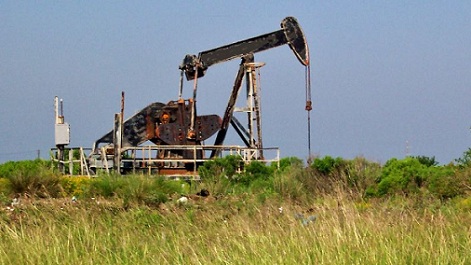This Week in Petroleum History, February 17 – 23
February 17, 1902 – Lufkin Industries founded in East Texas –
The Lufkin Foundry and Machine Company was founded in Lufkin, Texas, as a repair shop for railroad and sawmill machinery. When the pine region’s timber supplies began to dwindle, the company discovered new opportunities in the burgeoning oilfields following the 1901 discovery at Spindletop Hill.
Inventor Walter C. Trout was working for this East Texas company in 1925 when he came up with a new idea for pumping oil. His design would become an oilfield icon known by many names — nodding donkey, grasshopper, horse-head, thirsty bird, and pump jack, among others.
By the end of 1925, a prototype of Trout’s pumping unit was installed on a Humble Oil and Refining Company well near Hull, Texas. “The well was perfectly balanced, but even with this result, it was such a funny looking, odd thing that it was subject to ridicule and criticism,” Trout explained.
Learn more in All Pumped Up – Oilfield Technology.
February 17, 1944 – H.L. Hunt discovers First Alabama Oilfield
Alabama’s first oilfield was discovered in Choctaw County when independent producer H.L. Hunt of Dallas, Texas, drilled the No. 1 Jackson well. Hunt’s 1944 wildcat well revealed the Gilbertown oilfield. Prior to this discovery, 350 dry holes had been drilled in the state.
According to research by petroleum geologist Ray Sorenson, an 1858 report first noted Alabama natural oil seeps about six miles from Oakville in Lawrence County (see Exploring Earliest Signs of Oil). Hunt’s discovery well was drilled in Choctaw County, where he revealed the Gilbertown oilfield at a depth of 3,700 feet.
Although it took 11 years for another oilfield discovery, new technologies and deeper wells in the late 1980s led to the prolific Little Cedar Creek and Brooklyn fields. By the mid-2000s, geologic assessments were underway for the potential of the shales of St. Clair and neighboring counties.
Learn more in First Alabama Oil Well.
February 19, 1863 – First Pipeline Attempt to link Oilfield to Refinery
With teamsters dominating oil transportation in Pennsylvania, independent producer James L. Hutchings designed and constructed a pipeline to transport oil from a well on a farm at Oil Creek to a refinery 2.5 miles away. He had patented a rotary pump, which he used for moving the oil through two-inch piping from the Tarr Farm to the Humboldt Refinery at Oil City. His pumps worked, but the cast-iron pipeline proved impractical when the joints leaked.
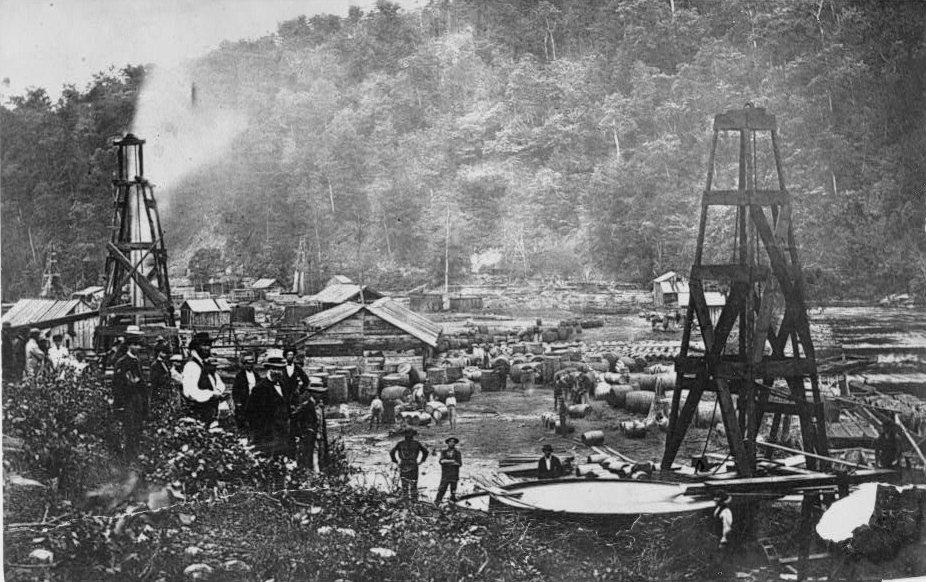
The 1863 pipeline attempt began from an oil well on the Tarr Farm (above) north of Oil City, Pennsylvania. December 1861 photograph by John Mather courtesy Library of Congress.
Hutchings’ concept of driving fluids with a rotary pump brought a key innovation for pipeline construction. In 1865, Samuel Van Syckel would break the teamsters’ monopoly by constructing a wrought iron pipeline with threaded joints that could transport 2,000 barrels of oil a day more than five miles — the first practical oil pipeline.
“It kind of shows you how multiple failures lead to success,” noted pipeline engineer Claudia Farrell in 2002. “The idea of driving fluids with a rotary pump sparked an innovation in the pipeline industry.”
February 20, 1959 – First LNG Tanker arrives in England
After a 27-day voyage from a processing facility just south of Lake Charles, Louisiana, the world’s first liquefied natural gas tanker arrived at Canvey Island in England’s Thames estuary, the world’s first LNG terminal. The experimental Methane Pioneer demonstrated that large quantities of LNG could be transported safely across the ocean.

The world’s first liquefied natural gas tanker, the Methane Pioneer, was a converted World War II Liberty freighter.
The first-of-its-kind vessel, a converted World War II Liberty freighter, included five 7,000-barrel aluminum tanks supported by balsa wood and insulated with plywood and urethane. Owned by Comstock Liquid Methane Corporation, the 340-foot ship kept its methane cargo refrigerated to minus 285 degrees Fahrenheit. In June 1964, the first purpose-built commercial LNG carrier — the nine LNG tank, 618-foot Methane Princess — began regular delivery to the same Canvey Island port.
February 20, 1993 – Oil Pipe Saxophone erected in Houston
Petroleum pipelines became a work of art when offbeat Texas sculptor Bob “Daddy-O” Wade debuted his blue, 70-foot saxophone at the opening of Billy Blues Bar & Grill on Houston’s west side.
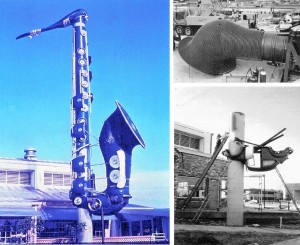
Petroleum pipeline segments contributed to a 1993 saxophone sculpture for Billy Blues Bar & Grill in Houston, Texas.
Wade transformed two 48-inch-wide pipes into the free-standing sculpture, adding an upside-down Volkswagen, chrome hubcaps, beer kegs, and assorted parts to complete his blue creation. After much debate, the Houston City Council deemed the oilfield pipeline saxophone to be art rather than signage. The Fort Worth Star-Telegram described Wade as a “connoisseur of Southwestern kitsch.”
Learn more in “Smokesax” Art has Pipeline Heart.
February 21, 1887 – Refining Process brings Riches to Rockefeller
Mining engineer and chemist Herman Frasch applied to patent a new process for eliminating sulfur from “skunk-bearing oils.” The former employee of Standard Oil of New Jersey was quickly rehired by John D. Rockefeller, who owned oilfields near Lima, Ohio, that produced a thick, sulfurous oil.
Standard Oil Company, which had accumulated a 40-million barrel stockpile of the inexpensive, sour “Lima oil,” bought Frasch’s patent for its copper-oxide refining process to “sweeten” the oil.

Herman Frasch (1851-1914), inventor of a key refinery process, by 1911 earned more wealth as the “Sulfur King.”
By the early 1890s, Standard Oil’s giant Whiting oil refinery east of Chicago was producing odorless kerosene from desulfurized oil, making Rockefeller another fortune.
Paid in Standard Oil shares and becoming very wealthy, Frasch moved to Louisiana — where the chemist made yet another fortune. By 1911, he was known as the “Sulfur King” after inventing a method for extracting sulfur from underground deposits by injecting superheated water into wells.
February 22, 1923 – First Carbon Black Factory in Texas
Texas granted its first permit for a carbon black factory to J.W. Hassel & Associates in Stephens County after scientists discovered carbon black increased the durability of rubber used in tires. Produced by the controlled combustion of petroleum products, carbon black could be used in many rubber products.
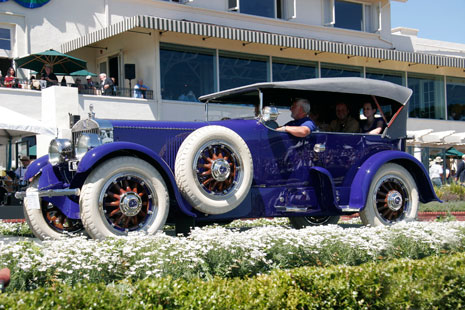
Early cars like the 1919 Pierce-Arrow had white rubber tires until B.F. Goodrich discovered carbon black improved durability. Photo courtesy Peter Valdes-Dapena.
Automobile tires were white until B.F. Goodrich Company in 1910 discovered that adding carbon black to the vulcanizing process improved strength and durability. An early Goodrich supplier was crayon manufacturer Binney & Smith Company (see Carbon Black and Oilfield Crayons).
February 23, 1906 – Flaming Kansas Gas Well makes Headlines
A small town in southeastern Kansas found itself making headlines when a natural gas well erupted into flames after a lightning strike. The 150-foot burning tower could be seen at night for 35 miles.
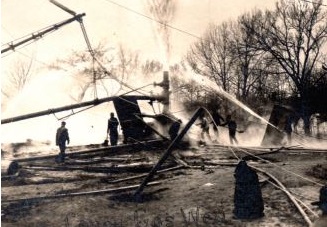
Kansas oilfield workers struggled to extinguish this 1906 well at Caney. Photo courtesy Jeff Spencer.
Drilled by the New York Oil and Gas Company, the well became a tourist attraction. Newspapers as far away as Los Angeles regularly updated their readers as technologies of the day struggled to extinguish the highly pressurized well, “which defied the ingenuity of man to subdue its roaring flames.”
A Denver publishing company sold postcards of the blazing Caney well, which took five weeks to smother using a specially designed and fabricated steel hood.
Learn more in Kansas Gas Well Fire.
February 23, 1942 – Japanese Submarine shells California Oil Refinery
Less than three months after the start of World War II, a Japanese submarine attacked a refinery and oilfield near Los Angeles. The shelling caused little damage but created the largest mass sighting of UFOs ever in American history.
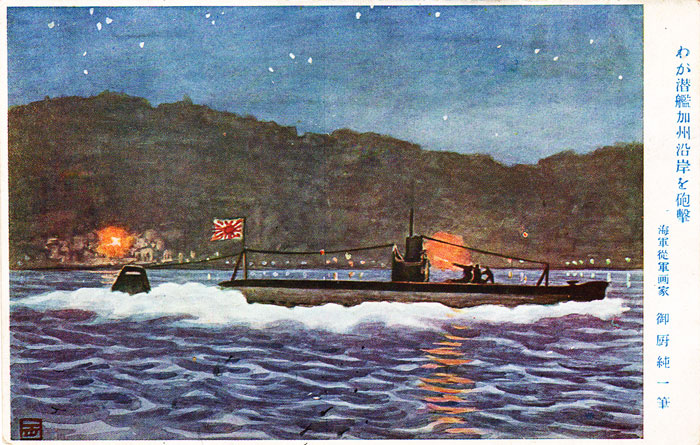
A rare Japanese postcard depicting the 1942 shelling of a California oil refinery by Imperial Navy submarine I-17. Image courtesy John Geoghegan.
Imperial Japanese Navy submarine I-17 fired armor-piercing shells at the Bankline Oil Company refinery in Ellwood City, California. The shelling north of Santa Barbara continued for 20 minutes before I-17 escaped into the night. The first Axis attack on the continental United States resulted in UFO sightings, mass hysteria and the “Battle of Los Angeles.”
Learn more in Japanese Sub attacks Oilfield.
_______________________
Recommended Reading:
Lufkin, from sawdust to oil: A history of Lufkin Industries, Inc. (1982); Lost Worlds in Alabama Rocks: A Guide
(2000); Petrolia: The Landscape of America’s First Oil Boom (2003); Natural Gas: Fuel for the 21st Century
(2015); Daddy-O’s Book of Big-Ass Art (2020); Herman Frasch — The Sulphur King (2013); The B.F. Goodrich Story Of Creative Enterprise 1870-1952
(2010); Caney, Kansas: The Big Gas City
(1985); The Battle of Los Angeles, 1942: The Mystery Air Raid
(2010). Your Amazon purchases benefit the American Oil & Gas Historical Society; as an Amazon Associate, AOGHS earns a commission from qualifying purchases.
_______________________
The American Oil & Gas Historical Society (AOGHS) preserves U.S. petroleum history. Please become an AOGHS annual supporter and help maintain this energy education website and expand historical research. For more information, contact bawells@aoghs.org. Copyright © 2025 Bruce A. Wells. All rights reserved.

